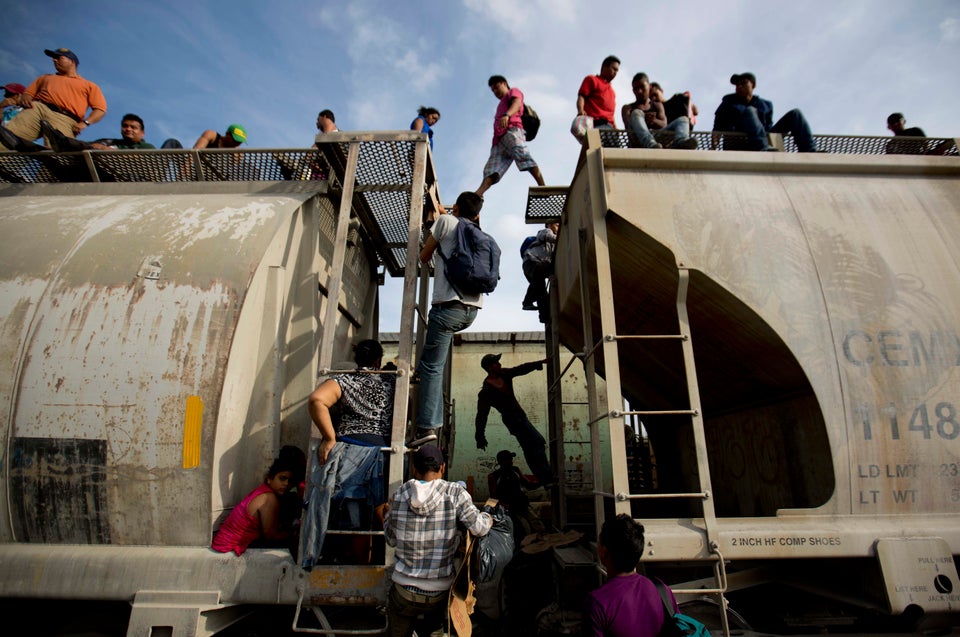
When José Luis Zelaya had reconstructive surgery on his nose last year to fix his breathing, he knew it was because he'd been punched in the face repeatedly, but he wasn't sure when. It could have been the many times his father struck him as a child, or it could have been from the times the "coyotes," as human smugglers are known in Latin America, punched him for speaking out loud and revealing his Honduran accent as he traveled illegally through Mexico on his way to the United States.
"I don't know, it could've been a combination of a lot of things," Zelaya, a Ph.D. student in urban education at Texas A&M University, told The Huffington Post. "I remember that journey, and every day I live with this. I remember those things."
Zelaya made his journey in 2000, when he was 13 years old. Around that time, U.S. authorities were apprehending roughly 6,775 unaccompanied minors a year for crossing the border illegally.
This year, immigration authorities expect a surge of more than 70,000 unaccompanied minors to cross illegally into the United States, the majority of them from the Central American countries of El Salvador, Guatemala and Honduras. Unlike Mexican minors, most of whom are repatriated immediately through a special process the U.S. only applies to Mexican and Canadian citizens, minors from Central America must be handed off to the Office of Refugee Resettlement. Once a child is given to the ORR, the office shelters him or her and usually locates a parent or guardian to whom he or she can be released while deportation proceedings are initiated. But the sudden surge of unaccompanied minors has overwhelmed a system designed to handle a capacity closer to 8,000 than 70,000.
The sharp increase of teenagers and preteens showing up at the U.S.-Mexico border from Central America has prompted conservatives to blame the White House for its 2012 Deferred Action on Childhood Arrivals policy, which exempts many undocumented immigrants brought here as children from deportation for a renewable two-year period. U.S. Rep. John Boehner (R-Ohio) called on President Barack Obama Friday to send National Guard troops to deal with the crisis. Conservatives have also blasted the Latin-American media, accusing reporters of spreading the false idea that newly arrived immigrants will benefit from DACA. In fact, only immigrants who were living in the U.S. before the policy was enacted may apply.
The White House denies the Republicans' allegations, contending that worsening conditions in Central America have led to what it calls an "urgent humanitarian situation" at the border. On Friday, the Obama administration announced it would "surge" its immigration enforcement at the Texas border to speed the deportations of recent arrivals. The administration also said it will open facilities to detain families that cross illegally, and will coordinate with Central American governments to spread the message that new arrivals crossing illegally will be returned.
But interviews with law enforcement officials, advocates and experts suggest that the DACA theory is inaccurate and the White House story is incomplete.
Like Zelaya, most of those coming to the United States are fleeing poverty and widespread violence at home, and seeking a relative here. At the same time, conditions in Guatemala, El Salvador and Honduras have opened an opportunity for smugglers to exploit the inefficiency of a U.S. immigration system universally denounced as "broken." Desperate families, often operating on the flawed premise that unaccompanied minors won't be deported if they make it across the border, are more than willing to take advantage of the situation if it means sheltering their children from war-like murder rates and grinding poverty.
A HISTORY OF VIOLENCE
Gang activity, growing involvement in the drug war and a history of political instability make Central America one of the most violent regions in the world. With a homicide rate of 90.4 per 100,000 inhabitants in 2012, according to the most recent available data from the U.N. Office on Drugs and Crime, Honduras is the world's most violent country outside of a war zone. El Salvador and Guatemala aren't far behind, with the world's fourth- and fifth-highest homicide rates, respectively. The already impoverished countries, whose economies are closely tied to the U.S. export market, saw poverty rates climb in the aftermath of the 2008 global financial crisis, according to World Bank data.

Masked members of the 18th Street gang give a press conference inside the San Pedro Sula prison in Honduras, Tuesday, May 28, 2013.
Adam Isacson at the Washington Office on Latin America, a non-governmental organization based in Washington, D.C., recently visited Mexico's southern border with Guatemala, where he said migrants invariably cited the need for money and security as the reasons driving them to leave their homes.
"The conversation with migrants is always economic," Isacson told HuffPost. "Then you scratch the surface for five minutes and it's problems with violence."
The United States, ironically enough, has played a major role in creating the messes in El Salvador, Honduras and Guatemala. Under the pretext of containing communism during the Cold War, the U.S. government ushered in decades of violent misrule and civil conflict in Guatemala by helping to overthrow the elected government of Jacobo Arbenz in 1954. Under similar justifications, the U.S. poured billions of dollars into the Salvadoran and Honduran militaries, even as they committed atrocities against civilians.
"We funded civil wars, which created enormous refugee problems," Isacson said. "We deported anyone who was in those communities that had a criminal record, which started the gang problem. And after the civil wars ended, we slashed our aid programs for almost anything besides drug war policies. To this day, you still can't significantly fund any of those priorities in Congress unless it's going through a counter-narcotics program."
Political instability has created a favorable environment for lawlessness. The region's recent spike in crime owes to the rise of hyperviolent gangs and drug cartels. Many unaccompanied minors interviewed by researchers said they left due to threats to their lives or their families from gangs attempting to recruit them, according to Mother Jones.
The violence and poverty isn't causing people from Guatemala, Honduras and El Salvador to come just to the United States. Since 2009, asylum applications from those three countries have skyrocketed 712 percent in the neighboring nations of Mexico, Panama, Nicaragua, Costa Rica and Belize, according to WOLA.
But most of the migrants wind up in the United States, for the simple reason that Central American migratory flows are long established, and many young people have family members here.
HUMAN EXPLOITATION
The children making this journey from Central America to the United States, crossing multiple borders illegally along the way, aren't doing it alone. Generally speaking, they are guided by human smugglers, known in Spanish as "coyotes," who charge the children's families thousands of dollars for the service.
Despite frequent exhortations from U.S. lawmakers to ramp up border security, illegal immigration from Mexico has in reality plummeted since the economic crisis of 2008, largely due to an improving Mexican economy and slackening demographic pressure on the Mexican labor market. With their primary market drying up, smugglers are pushing into Central America to find new clients, according to David Aguilar, former acting commissioner of Customs and Border Protection.
"This is an opportunity they're looking to exploit," Aguilar told HuffPost.
Meagan McKenna, the communications director for Kids in Need of Defense, an organization that represents unaccompanied minors facing deportation, echoed Aguilar's thoughts, though she emphasized that problems in Central America have done more to cause the crisis than the actions of smugglers.
"There's no question that smugglers are taking advantage of the situation, and the push factors and the desperation of their families," McKenna told HuffPost. "More girls are coming than ever before. And they're coming despite the fact that it's well known that many of these girls are sexually abused along the trip. I think that speaks to the desperation driving this."
A HOLE IN THE SYSTEM
If migrants believe that unaccompanied minors from Central America will be allowed to stay, it likely has little to do with DACA and a lot to do with the way those children are handled by the immigration system once they arrive.

Boys wait in line to make a phone call at the U.S. Customs and Border Protection Nogales Placement Center on June 18, 2014, in Nogales, Arizona.
The White House has repeatedly tried to dispel the idea that Central American minors who make it to the United States can stay here. But in practice, many do just that. Unlike Mexican minors who cross the border illegally, unaccompanied minors from Central America are not immediately repatriated. Instead, they are often given a notice to appear in immigration court and released to the custody of a family member residing in the United States.
At the same time, U.S. immigration courts are hopelessly backlogged. Depending on the jurisdiction, it could take years for someone who crosses illegally today to have his or her case decided in court, and many people never appear in court at all. Word of the hole in the immigration enforcement system has spread to Central America, according to The New York Times: Central American migrants interviewed by Times reporter Julia Preston in Texas referred to the notice they received to appear in immigration court as a "permiso," Spanish for "permit."
Republicans have tried to foist the blame for the problem on the White House, calling Obama lax on enforcement, despite the fact that his administration didn't invent the policy and has, indeed, carried out more deportations in six years than the George W. Bush administration did in eight. But simple enforcement won't solve the unaccompanied minors crisis anyway, says Aguilar, given the intractable root of problems in Central America and the issues facing the overloaded U.S. immigration system.
"Enforcement is a critical part of the solution to this problem, but it's not the sole solution," Aguilar told HuffPost. "What we'd be doing by sending more enforcement resources -- if that's all we do -- is creating a larger glove to catch more unaccompanied children."
The plan the Obama administration announced Friday includes making more immigration judges available to process deportation cases and asylum claims, in order to speed the removal of new arrivals.
In the meantime, children and teenagers lie cramped in overcrowded quarters as the federal government tries to find bed space for them. Zelaya says he's been losing sleep since photos began to surface this month of Central American minors packed into U.S. facilities too small to house them.
He asked why Central American undocumented minors can't be treated the same way the U.S. government treats Cuban nationals, who are allowed to become legal residents and apply for citizenship if they make it to U.S. soil under a policy known as "wet foot/dry foot."
"These kids made it, and now they're here," Zelaya said. "Why can't these children also be treated as refugees? That's what they're migrating for ... Think how much these children would really appreciate and love a country that would give them the opportunity to spend their lives here and help them. I am grateful to this country."

